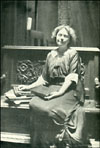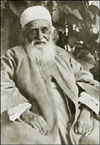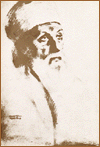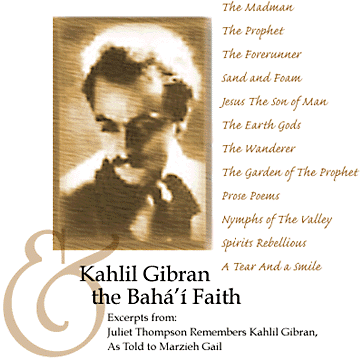 |
||||
Juliet Thompson was a portrait painter for nearly half a century and painted such notables as President Woodrow Wilson and Mrs Calvin Coolidge. |
||||
 |
||||
 |
||||
 |
||||||||||||||
Excerpts from: |
||||||||||||||
He told me definitely that [the book] The Son of Man was influenced by 'Abdu'l-Bahá. |
||||||||||||||
... For many years Juliet and Daisy Pumpelly Smythe, also an artist, shared a house in Greenwich Village, at 48 West 10th Street. They made their home a famous gathering place for people of many races and religions; and visits there, and fireside meetings, were almost continual. Many guests stayed there at "48," some for days or weeks. At one time Dimitri Marianoff, the former son-in-law of Albert Einstein, was writing a Baha'i book on the third floor, Juliet herself was revising her "I, Mary Magdalen" (a story inspired by 'Abdu'l-Baha, Whom she visited, as told in her Diary, in the Holy Land, Switzerland, and New York City) on the floor below, while I was in the basement sitting room, finishing "Persia and the Victorians." It was on April 6, 1943, in her studio-room, upstairs at the front of the house, that Juliet shared with me and a few other guests, these memories of Kahlil Gibran... He lived across the street from here," said Juliet Thompson, "at 51 West 10th. He was neither poor nor rich--in between. Worked on an Arab newspaper; free to paint and write. [1] His health was all right in the early years. He was terribly sad in the later years, because of cancer. He died at forty-nine. He knew his life was ending too soon. His drawings were more beautiful than his paintings. These were very misty, lost things--mysterious and lost. Very poetic. A Syrian brought him to see me--can't even remember his name. Kahlil always said I was his first friend in New York. We became very, very great friends, and all of his books--The Madman, The Forerunner, The Son of Man, The Prophet--I heard in manuscript. He always gave me his books. I liked The Prophet best. I don't believe that there was any connection between 'Abdu'l-Baha and The Prophet. But he told me that he thought of the 'Abdu'l-Baha all through. He said that he was going to write another book with 'Abdu'l-Baha as the center and all the contemporaries of 'Abdu'l-Baha speaking. He died before he wrote it. He told me definitely that [the book] The Son of Man was influenced by 'Abdu'l-Baha. He wrote his books in the studio across the street. Then he would call me up and say come over and hear a chapter. He was from an old Syrian family. His grandfather was one of the Bishops. I think he always remained a Greek Christian. I've seen Armenians and Syrians kiss his hand and call him Master. It was very bad for Kahlil. He had hundreds of followers. He kept that place closed to all except his intimate friends and his work. He was in love with a friend of mine--but he just loved me, and I loved him--but it wasn't that kind of love. He just wasn't a lover. He wasn't that kind of a man. He had a high, delicate voice and an almost shyly modest manner, until he came out with something thundering. I don't know how to describe him except to say he was the spitting image of Charlie Chaplin. I used to tell him so. It made him frightfully mad. How Gibran got in touch with the Baha'i Cause: I'll just frankly tell you the story, just as it was. I hastened to tell him he listened. He got hold of some of the Arabic of Baha'u'llah. He said was the most stupendous literature that ever was written, and that He even coined words. That there was no Arabic that even touched the Arabic of Baha'u'llah. He wore American business clothes. Had lots of black hair, wavy. Time passed. I told him the Master was coming. He asked me if I would request the Master to sit for him. The Master gave him one hour at 6:30 one morning. He made an outstanding head. It doesn't look like the Master--very faint likeness. Great power through the shoulders. A great radiance in the face. It's not a portrait of the Master but it's the work of a great artist. I do consider him a great artist."[2] He was very modest and retiring in his personal life. He'd never met the Master before, and that began his friendship. He simply adored the Master. He was with Him whenever he could be. He would come over here to this house (48 West 10th) to see the Master. In Boston, he was often with the Master. All that's sort of blurred because it's so long ago... ...The Master went away and Kahlil settled down into writing his books. But he often talked of Him, most sympathetically and most lovingly. Poor Kahlil! The end isn't so good. I was away. When I came back he was very sick. He asked me if I wouldn't come every day to see him. He was in bed. These were his last days. I want to give you all I can while I can. He would pour out the story of his life. So much of it was evaporated. He told me: 'When snow begins to fall it always wakes me up. One time at three in the morning I decided I'd like to go out and walk in the snow and get my thoughts together. So I went up to Central Park. I was walking with a little notebook in my hand. I was finishing The Earth Gods (an early book but his last). I was writing in my notebook in the snow. A big policeman came along.' 'Whatcha doin'?' Those last days he just wept and wept and wept. His head on my shoulder. He never said he was dying. He never said a word. Except that one thing: 'I want to give you all I can while I can. So come every day.' His followers stayed with him. He's quite a cult. Buried in Boston. Large, tragic brown eyes. The eye was very important in his face. His forehead was broad-very high-very broad, and he had almost a shock of black hair. Short, slender, five foot two or three. Very sensitive mouth drooped a little at the corners. Very sad man who had a reason for it. Little black moustache, like Charlie Chaplin. [End of article.] Excerpts from: WORLD ORDER A Baha'i Magazine |
||||||||||||||
Footnotes |
||||||||||||||
| |
||||||||||||||
|
||||||||||||||
| |
||||||||||||||
Links about Kahlil Gibran 1. This site has a gallery of some of the beautiful drawings done by Kahlil Gibran: http://impact.civil.columbia.edu/~fawaz/gibran.html |
||||||||||||||
* For more information about the Baháí Faith |
| |
| [Gibran Page] [Drawing] [Master] [Juliet] |
Website design by Pamela Jayawardena -All Rights Reserved 1997 Excerpts from: WORLD ORDER A Baha'i Magazine |
||